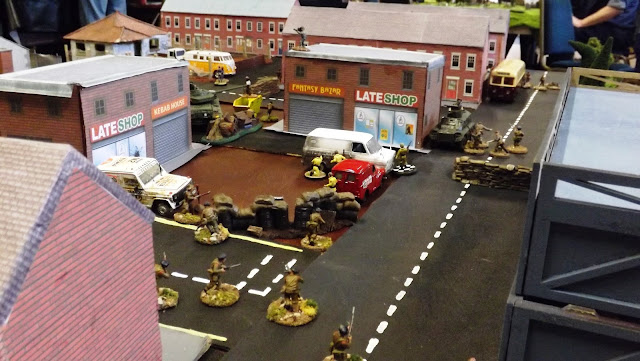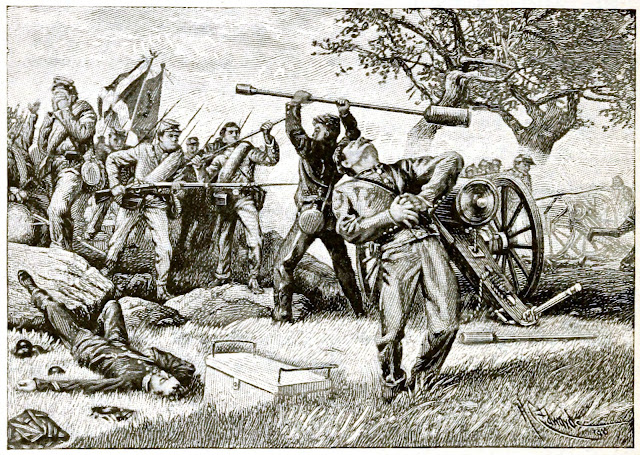and you can link to more details about both at JJ's Wargames in my post that preceded the game.
The picture below, taken on the IPad, shows the five German platoon group positions, corresponding to the map above with the British set to enter from the northern table edge.
Players order of battle and force notes adjusted for IABSM v3:
Elements
of 9th SS Hohenstauffen
One Big Man Level (III)
One Big Man Level (III)
One Big Man Level (II)
Platoon
One
Two MMG teams
(3 crew each)
Platoon
Two
Two MMG teams
(3 crew each)
Platoon
Three
Two MMG teams
(3 crew each)
Panzer
One - Morale 3
Three Panther
A tanks, dug in
Panzer
Two - Morale 3
Three Panther
A tanks
Mortars
Two 80mm
mortars off-table with three pre-registered target points (Use IPad
to record aiming points)
German Player Notes:
- Support
weapons, such as mortars or HMGs, will only move when activated by a Big Man or
if they come under close range small arms fire. They may move or fire in a turn
but never do both.
- Tripod‐mounted
weapons like medium or heavy machine guns will be unable to move if reduced to
a crew of one.
- Light
support weapons, such as LMGs or light mortar teams, will generally be
considered part of an infantry platoon. When they do operate independently they
move with the same number of Actions (4) as a full strength section of their troop type.
- The Germans
deploy their units in two deployment areas, as marked on the map as A and B.
They MUST deploy at least two whole platoon sized units in each deployment
zone. Both sides are on blinds when the game commences.
- One platoon of
German tanks must be dug in; all of their infantry may be as well.
- The hedges in
this area are not dense bocage, but remove one dice from any unit moving
through them.
- The side that
holds Le Haut Perrier at the end of the game wins.
 |
| The lead British elements enter the table on blinds with the first platoons spotted by the German defenders visible |
3
Company, 1st Welsh Guards
Big
Men
Lieutenant D.R
Leuchars (Level IV)
Lieutenant
D.J.C.Stevenson (Level III)
Sergeant E.
Williams (Level III)
Sergeant R.G. Fowles
(Level III)
Platoon
Seven
Two rifle
sections (8 men each)
One PIAT (2
man crew)
Platoon
Eight
Three rifle
sections
One PIAT (2
man crew)
Platoon
Nine
Three rifle
sections
One PIAT (2
man crew)
Elements
of 3rd Scots Guards Morale 3
Troop
One (Command Troop)
Three
Churchill tanks (Two Churchill VIIs, one Chuchill V CS)
Troop
Two
Three
Churchill tanks (Churchill VI's)
Troop
Three
Three
Churchill tanks (Churchill VI's)
HEAVY ARMOUR: Some tanks, such as
the Matilda II, Tiger or Churchill may be designated as having particularly
heavy all‐round armour protection. These tanks will roll one additional Armour
dice when fired at from the flank or rear.
British Player Notes:
- The British
start the game on the northern table edge.
- Both sides are
on blinds when the game commences.
- The British
have two additional dummy blinds to use.
- The hedges in this
area are not dense bocage, but remove one dice from any unit moving through
them.
 |
| The view up hill from the British lines |
As part of the setting up for this action and given the very cluttered nature of the terrain I wanted to keep the use of blinds to a minimum so had the Germans set up their platoon blinds out of sight of the British players and photographed their set up on the IPad together with the positions of their pre-registered mortar strikes.
Once recorded all the German markers were removed, using the IPad as a reference and thus the British were presented with an empty battlefield with just their blinds moving across the fields, with the Germans able to spot from their hidden positions.
 |
| Close Normandy terrain providing plenty of cover for friend and foe alike |
The German's opted for a balanced three up (6 x dug MG42 MMGs) forward in and around the farm, with Panthers on each flank, the right flank being dug in.
 |
| Scots Guards Churchill tanks on over-watch as their comrades move out into the neighbouring fields |
The British attack plan rather presupposes a move to bring the force to bear on a point in the German line looking to overwhelm it quickly and take out the other parts piecemeal, as is what happened. The tricky bit is getting to grips with the defenders without suffering too much on the way in, and there as the Great Bard would say "lies the rub of it".
 |
| It's quiet - To quiet! |
As the British forces entered the table using their two dummy blinds to disguise the line of attack, the German defenders spent the first few turns scanning the hedgerows down hill trying to spot the obvious sounds of enemy tanks and any supports.
 |
| Panthers dug in above the farm open fire and take return fire from the lumbering British tanks |
Very soon the first Churchill tanks were spotted looking like first year débutantes nervously making their way towards the dance floor. As well as tanks, the first two platoons of British infantry were soon spotted moving, two up, looking to get to the cover of the sunken lane.
 |
| The German positions were well dug in and camouflaged |
Radios crackled within German lines as the dug in Panthers on the right flank opened fire on the lead Churchill troop. The first shot ploughed harmlessly into the ground in front of the first vehicle causing an urgent rebuke for more care and attention from the SS tank commander to his gunner.
The gunner responded with a round that smacked into the front of the first Churchill and shot vertically upwards leaving the enemy tank unharmed. However the Scots Guards troop leaders relief was soon short lived as the other two Panthers opened up with aimed fire at the other two tanks in his command.
Their armour saved them from complete destruction, but left one immobilised permanently and the other temporarily but with impaired movement, plus the shock to their crews didn't help with their chances of returning the fire. Not surprisingly when they had their opportunity to respond the first vehicle smoke rounds appeared to their front aimed at giving them some respite.
 |
| The lead British tanks take casualties, shock and damage as the Guards infantry sprint to the sunken lane |
The poor old Welsh Guards were were getting a bit of battle inoculation as their lead platoon suddenly found themselves under mortar fire as they crossed the open field to their front, causing the survivors to sprint to the cover of the hedge on the sunken lane looking to regroup.
The dash to the hedge line only served to be a jump from the frying pan into the fire as two previously unspotted machine gun bunkers opened fire on the hapless Guardsmen, adding to their distress with further casualties and shock.
 |
| The Welsh Guards infantry come under whithering machine gun fire across the lane |
The British infantry commander was desperately in need of a bit of support from his "tankies", but they had a fight of their own going on, whilst aware of the need to close in on the German machine gun nests and help suppress them.
 |
| As if things couldn't get worse! The second Panther platoon move in on the Scots Guards flank |
Meanwhile the second Guards infantry platoon taking advantage of the attention being paid to their comrades took advantage of it to make their way forward on the German extreme right flank, making the sunken lane pretty much intact.
 |
| The Welsh have established a lodgement in the farm, clearing the MG nests, but the attacks stalls in the face of heavy casualties |
The Guardsmen were well aware that they had to break in amongst the cover of the buildings while using some of the tanks to keep the Panthers on the hill focused in their direction whilst also using some to support the infantry.
Making use of the smoke from the first tank casualties together with that of the defensive smoke rounds laid, the second troop moved through their comrades and brought HE fire onto the German MG nests on the sunken lane causing casualties and shocks.
The Welsh Guards used the respite given by their tanks to regroup and add to the pinning fire as one section sprinted over the lane through a neighbouring orchard and took the first MG nest in the flank and rear.
 |
| The dug in Panther platoon provided valuable support to their infantry in the farm area |
Whilst the attack in the centre was going on the third troop of Scots Churchills duked it out with the dug in Panthers, causing multiple hits on the enemy platoon commanders vehicle but remaining one shock away from causing the German commander to bail out.
Whist the German tanks were occupied with this duel, the second platoon of Welsh Guards desperately tried to plant a PIAT bomb onto the nearest German tank from their position on the sunken lane, but it struck harmlessly against the earthwork around the tank.
 |
| The British attack is halted with the survivors looking to disengage. The opposing tank platoons face off across the hill side as the battle subsides in the centre |
Sensing the distress of the British attack the SS commander pulled in his forces from the German left to counter attack the Guardsmen. This saw the second Panther platoon edge their way towards the flank of the British tank attack whilst two MG42 teams relocated into the farm barns to secure the centre.
The Welsh Guards section that had cleared the first bunker then took out its neighbour and got a lodgement in one of the barns, but by then the attack had stalled with too many infantry casualties littering the nearby fields and the Scots looking likely to be caught in the vice of two platoons of Panther tanks one on each flank,
And that was, as they say, that with the British attack stopped in its tracks.
This game was bad day at the office for the Brits, with their attack managing to find the dug in Panthers rather than their mobile comrades, and with their dice failing miserably to save casualties, only by an uncanny ability for the Germans to do the opposite.
I think we were generous on the cover we gave the British moving through the hedges and trees that break up the terrain; usually making them an 'okay' to 'poor' target on the IABSM fire table. On reflection I would make the sunken lane a 'poor' target environment along its length in front of the farm giving a jump off point for the Brits that make it across the field to the front of the buildings.
The Churchill proved a tough opponent taking hits that would automatically brew Shermans and Cromwells and the use of 'Engage' orders with aimed shooting certainly kept the Panthers on the hill busy fending off their shots.
A very nice afternoon spent battling in the Normandy countryside provided great sport before the rugby match of this year's Six Nations competition was caught up with in the pub afterwards.
Thanks to Ian, Steve, Steve M., and new member Bob for providing the entertainment.


















































